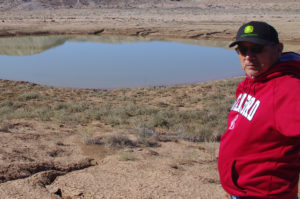
The Livestock Forage Program helped the ranch recover after severe drought.
By Arnie Schlittenhart, Arizona Farm Service Agency
Last November, Al Thomas surveyed the barren rangeland on his Silver Spur Ranch, located near the Tolani Lake Chapter of the Navajo Nation in north-central Arizona.
Just 18 months earlier, Al had enough green forage to support his herd of 40 cow-calf pairs. Unfortunately, last year’s severe drought forced him to reduce his herd to only nine cows.
Dealing with Drought
“We didn’t get any significant rainfall in 2017 and through three-quarters of 2018,” Al said. “Unfortunately, we had to start reducing our herd in late August 2018 because we didn’t know if we were going to get any rain. Most of the forage started oxidizing because of the lack of rain; it was something that I never experienced as a rancher.”
Al contacted his local USDA Farm Service Agency (FSA) office in Flagstaff and applied for the Livestock Forage Disaster Assistance Program (LFP), which provides livestock producers with assistance for grazing losses due to drought.
“The drought assistance funds sure came in handy. I used the funds to pay for hay, mineral and protein supplement tubs and water for our cattle,” he said. “The funds also supplemented our own dollars, which made it a little easier to endure the drought. Our cattle surprisingly stayed healthy and in good body condition.”

Al increased his livestock watering capacity through the Environmental Quality Incentives Program.
Maintaining Infrastructure
Al displayed the resilience inherent in most ranchers by not only maintaining the health of his remaining herd, but also by maintaining and improving his ranch’s infrastructure.
Leveraging cost-share assistance through the Environmental Quality Incentives Program (EQIP), administered by USDA’s Natural Resources Conservation Service (NRCS), Al increased his livestock watering capacity by installing additional holding tanks, piping, and natural water catchment structures.
Through EQIP, agricultural producers may receive financial and technical assistance to implement structural and management conservation practices that optimize environmental benefits on working agricultural land.
Like many ranchers, Al continues to exemplify the spirit of relentless determination by embracing a positive attitude, even through difficult times.
“On the positive side, we’ve received much more moisture this winter which is good,” he said.
With hopes of his forage returning, he plans to add more yearling heifers to rebuild his operation.
More Information
USDA offers a variety of risk management, disaster assistance, loan, and conservation programs to help agricultural producers in the United States weather ups and downs in the market and recover from natural disasters, as well as invest in improvements to their operations.
For more information about USDA programs and services, contact your local USDA service center.





